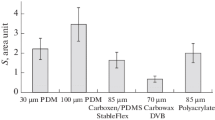Abstract
The analytical challenges of Pt determination by ICP–SFMS posed by different human tissues and fluids have been critically assessed. Investigated samples were (1) urine, (2) serum of cancer patients sampled during chemotherapy with carboplatin, (3) microdialysates (20 µL sample volume) collected from tumor and non-tumor tissue, and, finally—for the first time—(4) human lung tissue to study background concentrations of inhaled platinum. Sample preparation involved microwave digestion and open vessel treatment or simple dilution (microdialysates). Depending on the sample preparation and introduction systems used (microconcentric nebulization, ultrasonic nebulization with and without membrane desolvation) excellent procedural detection limits (3s criterion) of 0.35 pg g−1 for urine, 420 pg g−1 for serum, 400 pg g−1 for lung tissue and 13 pg g−1 for microdialysates could be obtained. Ultratrace concentrations of 1–40 pg g−1, and 1000–3000 pg g−1 were measured in urine and human lung tissue, respectively, as typical for samples in environmental studies. Quantification was carried out by IDMS and standard addition in the case of urine samples. Internal standardization could not correct for non-spectral interferences in external calibration. In the serum and microdialysates of patients during chemotherapy with carboplatin, elevated Pt levels ranging between 0.01 and 10 µg g−1 were determined by external calibration (195Pt isotope). For all investigated samples spectral interferences could be excluded by following different strategies. High-resolution control measurements (194Pt, 195Pt) were performed in the case of elevated Pt levels, i.e. for microdialysates and serum samples. An Hf/Pt ratio of 0.4 was determined in human lung samples. An HfO formation ratio of 0.2% was assessed for standard solutions at the present experimental conditions, revealing that the contribution of 179Hf16O, 178Hf17O, 177Hf18O to the 195Pt isotope signal used for quantification was not significant.



Similar content being viewed by others
References
Palacios MA, Moldovan M, Gomez MM (1999) In: Zereini F, Alt F (eds) Anthropogenic platinum group element emissions. Springer, Berlin Heidelberg New York, p 3
Barefoot RR, Van Loon JC (1999) Talanta 49:1
Rao CRM, Reddi GS (2000) Trends Anal Chem 19:565
Haverland GW, Wiebe LI (1991) Int J Rad Appl Instr 42:775
Parry SJ (1992) J Geochem Explor 44:321
Artem'ev OI (1993) J Radioanal Nucl Chem 173:125
Hoppstock K, Alt F, Camman K, Weber G (1989) Fresenius J Anal Chem 335:813
Helmers E, Mergel N (1998) Fresenius J Anal Chem 362:522
Krachler M, Alimonti A, Petrucci F, Irgolic KJ, Forastiere F, Caroli S (1998) Anal Chim Acta 363:1
Bergerov J, Turfeld M, Dunemann L (1997) J Anal At Spectrom 12:1095
Köllensperger G, Hann S, Stingeder G (2000) J Anal Atom Spectrom 15:1553
Helmers E, Kümmerer K (1999) Environ Sci Pollut Res 6:29
Artelt S, König HP, Levsen K, Kock H, Rosner G (1999) Atmos Environ 33:3559
Ely JC, Neal CR, Kulpa CF, Schneegurt MA, Seidler JA, Jain JC (2001) Environ Sci Technol 35:3816
Beyer JM, Zereini F, Artelt S, Urban H (1999) In: Zereini F, Alt F (eds) Emissionen von Platinmetallen – Analytik, Umwelt- und Gesundheitsrelevanz, Springer, Berlin Heidelberg New York, p 131
Claus T, Zereini F, Urban H (1999) In: Zereini F, Alt F (eds) Emissionen von Platinmetallen – Analytik, Umwelt- und Gesundheitsrelevanz, Springer, Berlin Heidelberg New York, p 147
Helmers E (1997) Environ Sci Pollut Res 4:100
Schäfer J, Eckhard J, Berner Z, Stüben D (1999) Environ Sci Technol 33:3166
Jarvis K, Parry S, Piper J (2001) Environ Sci Technol 35:1031
Kümmerer K (2001) Chemosphere 45:957
Kümmerer K, Helmers E, Hubner P, Mascart G, Milandri M, Reinthaler F, Zwakenberg M (1999) Sci Total Environ 225:155
Begerow J, Dunemann L (1999) In: Zereini F, Alt F (eds) Anthropogenic platinum group element emissions. Springer, Berlin Heidelberg New York, p 227
Brunner M, Müller M (2002) Eur J Clin Pharmacol 58:227
Müller M (2002) Br Med J 324:588
Eurachem (2000) Quantifying uncertainty in analytical measurement. Eurachem, London, 2000
Acknowledgement
We acknowledge the financial support by the Oesterreichische Nationalbank (Project number: 9561) for the determination of Pt in lung tissue. Microdialysis experiments were supported by a grant (Nr. P13823-MED) from the FWF, the Austrian Science Fund (Fonds zur Förderung der Wissenschaftlichen Forschung).
Author information
Authors and Affiliations
Corresponding author
Rights and permissions
About this article
Cite this article
Hann, S., Koellensperger, G., Kanitsar, K. et al. Platinum determination by inductively coupled plasma–sector field mass spectrometry (ICP–SFMS) in different matrices relevant to human biomonitoring. Anal Bioanal Chem 376, 198–204 (2003). https://doi.org/10.1007/s00216-003-1861-x
Received:
Revised:
Accepted:
Published:
Issue Date:
DOI: https://doi.org/10.1007/s00216-003-1861-x




